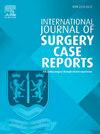用 WALANT 技术治疗 COVID-19 患者的急性手臂隔间综合征:病例报告。
IF 0.6
Q4 SURGERY
引用次数: 0
摘要
简介:筋膜室综合征是一种外科急症,由封闭的筋膜室内压力升高引起,导致组织灌注受损,如不及时治疗可能造成不可逆的损伤。本报告介绍了一例罕见的上肢筋膜室综合征病例,该病例发生在一名多次静脉穿刺失败后接受抗凝治疗的 COVID-19 患者身上。该病例符合 SCARE 标准:一名患有高血压、糖尿病和先天性脑积水的 67 岁男性因 COVID-19 肺炎入院。由于血栓栓塞风险较高,他需要使用依诺肝素进行抗凝治疗。在多次尝试确保右上肢静脉通路失败后,患者的肢体出现剧烈疼痛、肿胀和麻木。临床检查发现患者面色苍白、麻痹和无脉搏,怀疑是室间隔综合征。超声波检查证实没有桡动脉和尺动脉血流,手臂前室有明显的肌肉水肿和血肿形成。由于患者肺部受损,全身麻醉风险较高,因此决定采用 WALANT(宽醒局部麻醉无止血带)技术进行筋膜切开术。术后,在清除了压迫肱动脉的深层血肿后,搏动恢复了,手部灌注立即得到改善。患者被转回传染科继续接受COVID-19治疗,术后恢复顺利。随访 6 个月时,患者的肩、肘、腕和手指已完全恢复活动能力:本病例强调了在接受 COVID-19 抗凝治疗的患者中发生上肢室间隔综合征的罕见情况,很可能是由于静脉穿刺相关创伤所致。该病例凸显了诊断和处理重症患者筋膜室综合征所面临的挑战,并证明了 WALANT 技术在对高危患者实施筋膜切开术时的实用性。早期识别和及时干预对确保患者完全恢复功能至关重要:结论:接受抗凝治疗的患者,尤其是多次尝试静脉穿刺的患者,应考虑室间隔综合征。WALANT技术为重症患者的筋膜切开术提供了一种可行的手术选择。本文章由计算机程序翻译,如有差异,请以英文原文为准。
WALANT technique for acute compartment syndrome of the arm in a COVID-19 patient: A case report
Introduction
Compartment syndrome is a surgical emergency caused by elevated pressure within a closed fascial compartment, leading to compromised tissue perfusion and the potential for irreversible damage if not treated promptly. This report presents a rare case of upper limb compartment syndrome in a COVID-19 patient on anticoagulation therapy following multiple failed venipuncture attempts. This work has been reported in line with the SCARE criteria.
Case presentation
A 67-year-old man with hypertension, diabetes, and congenital hydrocephalus was admitted for COVID-19 pneumonia. He required anticoagulation therapy with Enoxaparin due to his high risk for thromboembolic events. Following multiple failed attempts to secure venous access in the right upper limb, the patient developed severe pain, swelling, and numbness in the limb. Clinical examination revealed pallor, paresthesia, and pulselessness, raising suspicion of compartment syndrome. Ultrasonography confirmed the absence of radial and ulnar arterial flow, with evidence of significant muscular edema and hematoma formation in the anterior compartment of the arm.
Due to the patient's pulmonary compromise and elevated risk for general anesthesia, the decision was made to perform a fasciotomy under the WALANT (Wide Awake Local Anesthesia No Tourniquet) technique. Following the procedure, pulses were restored after evacuation of a deep hematoma compressing the humeral artery, with immediate improvement in hand perfusion. The patient was transferred back to the infectious diseases department for continued COVID-19 management, and the postoperative course was uneventful. At 6-month follow-up, the patient had fully recovered mobility of the shoulder, elbow, wrist, and fingers.
Discussion
This case underscores the rare development of upper limb compartment syndrome in a patient on anticoagulation therapy for COVID-19, likely due to venipuncture-related trauma. It highlights the challenges of diagnosing and managing compartment syndrome in critically ill patients, and demonstrates the utility of the WALANT technique in performing fasciotomy in high-risk patients. Early recognition and timely intervention were crucial in ensuring the patient's full functional recovery.
Conclusion
Compartment syndrome should be considered in patients on anticoagulation therapy, particularly those with multiple venipuncture attempts. The WALANT technique provides a viable surgical option for fasciotomy in critically ill patients.
求助全文
通过发布文献求助,成功后即可免费获取论文全文。
去求助
来源期刊
CiteScore
1.10
自引率
0.00%
发文量
1116
审稿时长
46 days

 求助内容:
求助内容: 应助结果提醒方式:
应助结果提醒方式:


